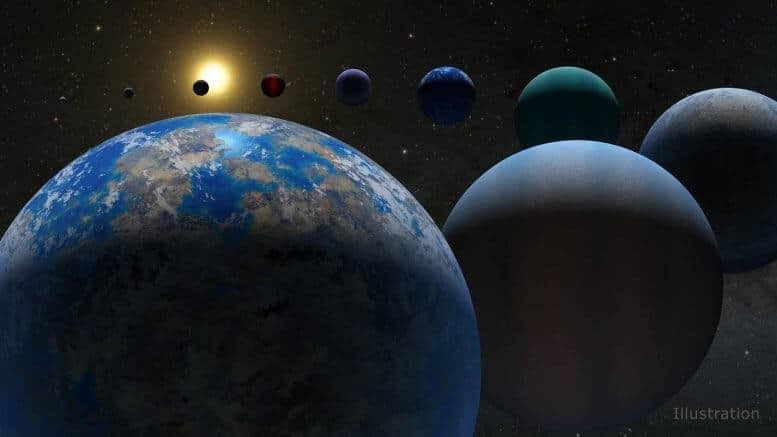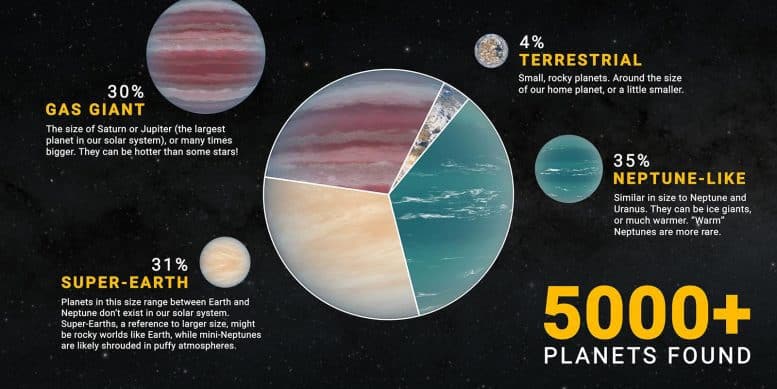Given the hundreds of billions of planets in the Milky Way alone, "it's inevitable that we'll find some form of life somewhere"

The number of confirmed exoplanets has just passed the 5,000 milestone, after a thirty-year discovery campaign led by NASA space telescopes.
Until recently, we lived in a universe where only a small number of planets were known, all of which orbited the sun. But a large number of new discoveries marks a scientific record: there are now more than 5,000 planets whose existence has been confirmed beyond our solar system.
The planet count passed 5,000 on March 21, with the latest batch of 65 planets added to NASA's extrasolar planet archive. The archive records discoveries of planets and exoplanets that appear in peer-reviewed scientific articles, and that have been confirmed using several detection methods or analytical techniques.
The 5,000-plus planets found so far include small, rocky worlds like Earth, gas giants many times larger than Jupiter, and many "hot Jupiter" planets orbiting their star in close, hot orbits. There are "super Earths", which are possible rocky worlds larger than our world, and "mini-Neptunes", smaller versions of Neptune in our solar system. And add to the mix planets that orbit two stars at the same time and planets that stubbornly orbit the remains of dead stars that have collapsed.
"It's not just a number," said Jesse Christiansen, the archive's scientific director and a research scientist at NASA's Extrasolar Planet Science Institute at Caltech in Pasadena. "Each of them is a new world, a completely new planet. I'm excited about each one because we don't know anything about them."
We know this: there are probably hundreds of billions of such planets in our galaxy. The ongoing stream of discoveries began in 1992 with strange new worlds orbiting an even stranger star. It was a type of neutron star called a pulsar, a rapidly spinning stellar corpse that pulsates with powerful millisecond bursts of radiation. Measuring small changes in the timing of the pulses allowed scientists to discover planets orbiting the pulsar.
Only three planets were found orbiting this swirling star and then the flood began, said Alexander Walshchen, lead author of the paper that 30 years ago revealed the first confirmed planets outside our solar system.
"If you can find planets around a neutron star, then planets must be almost everywhere," Walshchen said. "The process of creating the planets has to be very strong."

5000 Exoplanets_H.docx

6 תגובות
May his name be praised for ever and ever. How many are your wonders. With wisdom you made the moon and the stars and let them rule the night and the sun by day. The unbelieving scientists grope in the dark and do not see. What the sages of the Talmud see clearly... and the statement that there is no end to the stars is a true and well-known statement. To the sun there is nothing new under the sun, said the wisest of all, peace be upon the king.
And at the same time it is not impossible that there is indeed life outside the earth. Not really close and not really soon. Out of hundreds of billions of stars there must be at least one or two and even if you want to joke - it's still a possibility
Statistically it is indeed inevitable that we will find life somewhere, but to say that it is inevitable that we will find them is a bit presumptuous. Somewhere in the infinite universe, on one of the planets near one of the stars in one of the galaxies - there is life. If it happened here, it could happen, and any chance that it could happen multiplied by the huge number of planets in all the galaxies leads to the conclusion that it probably happened, is happening or will happen somewhere else. But when you narrow it down with the unimaginable distances and taking into account the narrow window of time they were found by us (overlap between the period of our existence and the period of their existence) - it is certainly not serious to say that it is inevitable that *we* will find them.
There are so many aspects to the question of how life is possible on other planets that it is a bit strange to insist on stating in every possible sub-heading that it is "inevitable" that there will be life somewhere, to the point of being suspected of being slightly unscientific.
We currently rely on a number of parameters for the possibility of life that are still taken from the old Drake equation, and we haven't updated it that much. Most of the stars in the galaxy are red dwarfs, and they tend to scorch their planets (which are in the habitable zone, very close to them) at times. A large part of the galaxy is an unfriendly and radiation-rich place, close to the center, and the part on the outskirts is poor in heavy materials, it is claimed, necessary for life to exist.
In any case, if the theory and the possibility of panspermia is correct, then it is possible that we in the solar system and on Earth have been seeding the galaxy with our seeds of life for some billions of years, and the aliens we meet will be nothing but our lost relatives, based on DNA and RNA and ribosomes and genetic code Similar.
The new space telescope discovered an ultra-Orthodox state on a planet 700 light years from Earth. There are large public buildings and superior technology and all the men up to the age of 450 work and also enlist in the galactic army.
There is a quantum leap between the article and the subtitle regarding finding life.
The article talks about planets and the title has a supposedly unequivocal scientific statement about finding life.
We would be happy to see scientific substantiation for the fact that it is "inevitable that we will find some type of life somewhere"
By the way, in the original this paragraph is much less unequivocal and it is clear that it is built on hypotheses and not on evidence.
In addition, NASA did not put a subtitle about finding life.
"To my thinking, it is inevitable that we'll find some kind of life somewhere - most likely of some primitive kind," Wolszczan said. The close connection between the chemistry of life on Earth and chemistry found throughout the universe, as well as the detection of widespread organic molecules, suggests detection of life itself is only a matter of time, he added.